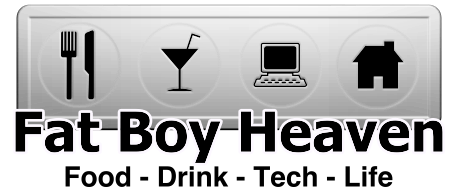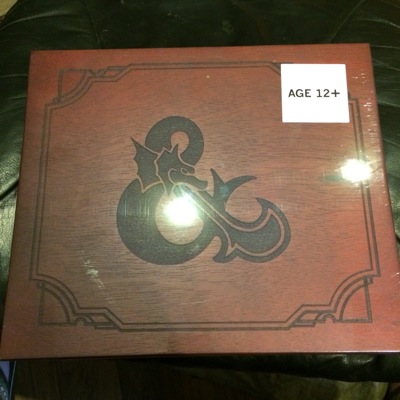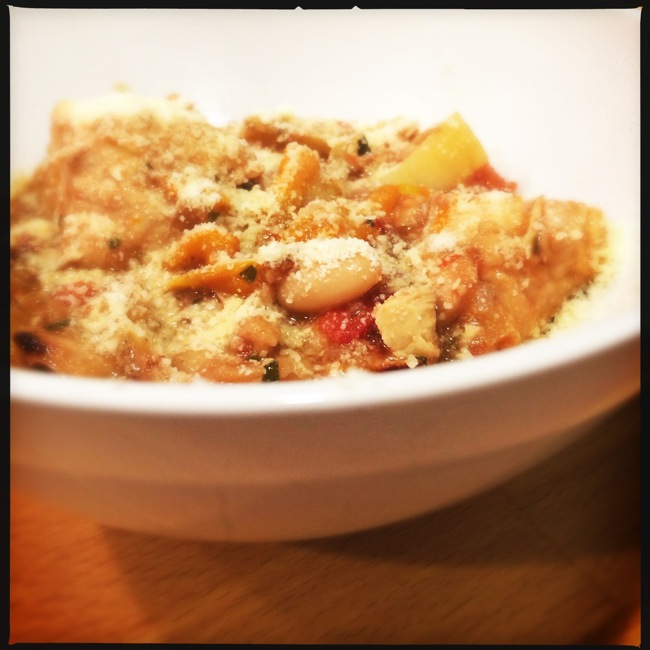Growing up, St. Patrick's Day was "boiled dinner". Corned Beef and Cabbage cooked all day on the stove, allowing flavors to mix and make a delicious dinner to serve the whole family. If we were lucky and weren't very hungry that night, there were enough left over potatoes and corned beef for Dad to make hash the next morning. Twelve years after Dad has passed away, it is still the dinner I fall back to on St. Paddy's Day.
Read moreReview: Sesame Donuts - 185th and Jenkins
Sesame Donuts newest store at 185th and Jenkins in Hillsboro
One of my favorite donut places in the state is Sesame Donuts. Their original store on Beaverton-Hillsdale highway in Portland has been one of the goto places for donuts in town for a long time. Their newest location in Hillsboro is a godsend for me. I'll be there quite often.
Read moreWhisky Tasting: 21 yo Whisky Face Off
21 yo Ben Nevis Highland Single Malt
Last night I got together with some old buddies from Woodburn High School to catch up, and thought it would be a good chance to compare a couple of 21 yo Single Malt's with a 21 yo Bourbon side by side. Not all of the guys were interested in tasting them all, but we had a consensus on flavor profiles among those of us who did.
Read moreWhisky Review: Johnny Drum Private Stock
Johnny Drum is one of those elusive bourbons that we hear about on the west coast but never have a chance to taste, so when I came across this bottle I had to pick it up.
The green label is far more common even on the east coast, this Private Stock bottle I had to get directly from the distillery when we visited the folks at Willett in April of last year. Now that I've taken the time to taste it I only wish I had brought back a case instead of a single bottle. This bourbon won double gold at the 2010 San Francisco World Spirits Competition, besting the field with good reason.
Here are my tasting notes:
Review: McMenamin's The Sand Trap Pub at The Gearhart Hotel
Located in the historic Gearhart Hotel, The Sand Trap Pub is classically McMenamin's. Art Deco decor dominates the design of this newest hotel in the McMenamin's chain which opened in March of 2012.
Read moreWhisky Heaven: Medley Bros. Bourbon - 4yo vs. 12yo!
I love Bourbon, in case you are new and have not figured that out yet I figured I better lay that out here right now. One of the things I love is seeing what effect aging has had on a decent bourbon. Is it best after four years or six? Does the recipe have enough sugar to hold up to the barrel and come out better after ten or twenty years than it was when it was meant to be bottled at four? What different flavors and smells are added or removed with time in supposedly "identical" barrels?
Read moreReview: Cheri's Cafe, Cannon Beach
Cool little Cafe in Cannon Beach, featuring breakfast and lunch with a full service bakery. From fresh baked goods to pizza and burgers, the menu is diverse.
Read moreReview: Famous Dave's BBQ Shack, Cedar Hills
The BBQ Shack is casual BBQ done right
My buddy Mark called and asked if I had time to have lunch with him today since he was up in my part of town, and I love to get together with old friends, so we had a late lunch. Famous Dave's opened this little BBQ shack on Cedar Hills BLVD. In Beaverton, so we decided to see if it was as good as their restaurant in Tualatin.
Read moreReview: Guiseppe's Italian Restaurant
Guiseppe's is an old world Italian restaurant in Gresham. Featuring a great menu, with classic dishes at decent prices, Guiseppe's is a great restaurant that deserves a visit if you are looking for classic Italian on Portland's east side.
Read moreKickstarter Project: Stackerware
I stumbled across this great project on KickStarter tonight, and they are in need in help to get their project off the ground.
The idea is fairly simple: easily stackable food storage containers in three sizes (16, 24, and 32oz) with interchangeable lids. A couple of things set this project apart from others on the market: first is a patent pending storage system with hooks that allows for a wide range of storage options, and second is the materials used. The containers are microwave, freezer, and dishwasher safe as well as certified BPA free. What this means is that they can be easily organized and kept track of so gone are the days of cluttered drawers and cabinets of mismatched lids and containers, as are the frustrations of lids shrinking or containers warping and no longer being usable.
You can find more info on the project here .
New Channel available for AppleTV Owners - WWE Wrestling!
Part of yesterdays update to the Apple TV was the addition of a WWE channel, allowing fans of the popular Wrestling network to subscribe to content and access PPV events directly from their AppleTV for a $9.95/month charge directly billed through iTunes. Follow the link for more info.
World Wrestling Entertainment Channel Now Available for iOS and Apple TV - Mac Rumors:
World Wrestling Entertainment Channel Now Available for iOS and Apple TV
Dinner Tonight: Fat Boy Heaven's Gluten Free Fettuccine Alfredo with Sausage
Fettuccine Alfredo can be served with any protein, not just chicken or shrimp.
My kids were out of school today, and my son asked for fettuccine alfredo for dinner. I didn't want to do it with chicken like we normally do, but as I was thinking about it I realized that I had never posted my Alfredo recipe here.
Read moreDinner Tonight: Fat Boy Heaven's Gluten Free Bacon Feta Macaroni and Cheese with Dates
One of the things you may have noticed by now is how much we LOVE comfort food here at Fat Boy Heaven. There is nothing that epitomizes comfort food for most of us more than a nice rich Mac and Cheese, but it would get boring if it was always the same. I decided that the saltiness of the feta might tie in nicely with the smokey saltiness of the bacon very nicely, and since feta doesn't melt, provolone was a nice neutral base cheese to develop the sauce. I added the dates as the milk was first coming to a boil so that some of the sugar would help sweeten the sauce to offset the salt.
Read moreReview: Dungeons and Dragons Premium Deluxe Edition - Original White Books
The Classic Edition arrives in a beautiful carved wooden box.In December of last year Wizards of the Coast announced a Premium reissue of the Original Dungeons and Dragons set that started a revolution in gaming for it's 40th Anniversary. It has been hard to come by due to limited release, but they finally got mine to me today, and it is just as I hoped it would be.
For those of you too young to remember the original Dungeons and Dragons, before there was AD&D with it's modified rules, and even before the simplified "Red Book" set came out was the original "White Book" set released by TSR Games in 1974. It consisted of seven rules booklets, a booklet of reference sheets, and a set of five dice that literally changed the world. I know many games and books have made this claim, but there is not a gamer, movie, or TV fan alive that does not owe a part of their entertainment for the last 40 years to this game.
D & D was the first game that taught our youth that creating stories was just as valuable as retelling them. It is fitting that it was released by TSR, a company founded as a way for some friends to make money from their hobby of war reenactment gaming. They had speant hours and hours gaming and at conventions retelling stories of battles throughout history. Now they had come up with a game that allowed them to write their own stories, and make worlds up out of whole cloth for their friends and family to play their way through; creating new stories for them to retell their friends.
The Box Set is beautiful, and quite frankly the books are printed on better quality paper than the originals. The set is a fitting tribute to the history of the game, and a great way to bring a new generation of gamers into the world of fantasy role playing.
Dinner Tonight: Ham and Cheese Scones with Bacon Gravy
Like any Fat Boy, I love biscuits and gravy. I sometimes get tired of the same old thing though, so I decided to try taking biscuits and gravy up a level. In place of biscuits I went with a savory scone filled with ham and cheddar cheese, and I smothered it in a classic bacon gravy.
Read moreReview: Typo Keyboard
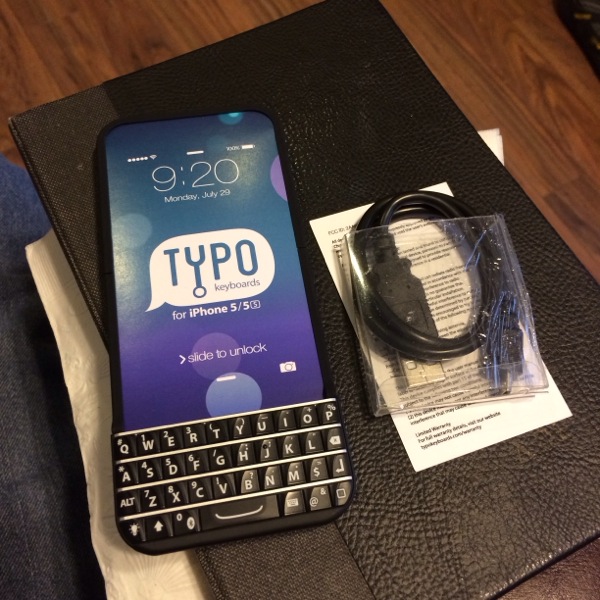
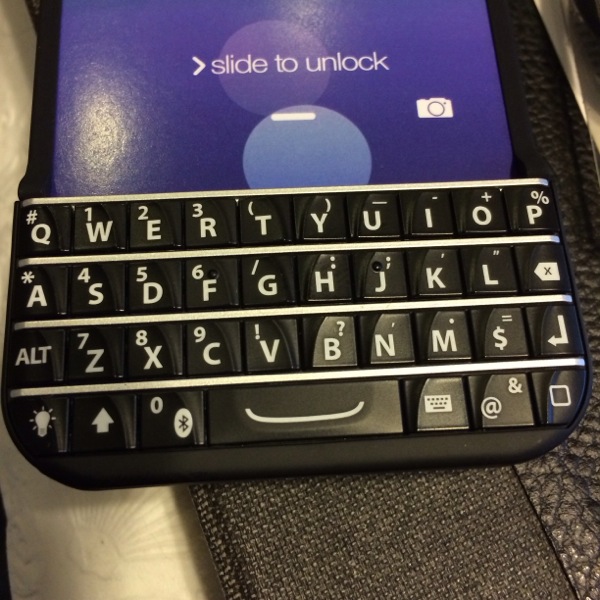
Today I received the Typo Keyboard, made famous by way of Ryan Seacrest's investment in the company and the lawsuit they face from Blackberry over the layout of their keyboard.
Right off the bat, the fact that the keyboard needs to be plugged in separately from the phone is a killer. The second thing you notice is that typing here isn't nearly as easy as it should be. At least for my thumbs, typing is cramped and difficult to get up to speed even after 20 minutes of practice.
The good news is it adds very little bulk or size to the unit. It feels good in the hand, and is responsive to touch.
If you really need a full time keyboard on your iphone it might be a good try, but for me the short comings make the $100 price tag far too high.
A Judge ruled late yesterday that there was sufficient cause to believe Typo would lose their lawsuit brought by Blackberry, and therefore ordered an injunction against marketing and sales of the product. More details can be found on Engadget here.
Review: Salted Chocolate Covered Caramels from The Candy Basket
In 1934 The Candy Basket Inc. opened its doors, hand making delicious chocolate confections to delight its local communities. Several generations and three factories later they have grown into a full line confectioner offering a wide variety of chocolates, toffees, brittles, fudges, corns, and jells. It is their goal to bring their customers memories of grandma’s “Heavenly Divinity”, mom’s amazing “Red Velvet Cake (truffle)”, and the summer time treat we all enjoyed as kids, dreamy “Creamsicle Fudge”, of course…It’s all just Pure & Simple.
Read moreDinner Tonight: Fat Boy's Chicken Cacciatore
I was trying to decide how to use some chicken that had been sitting in the fridge all weekend, and decided a nice rustic cacciatore would be perfect on this cold winter night.
Read morePhoto Review: Paper - FaceBook has never looked better
Today FaceBook released a new way for iPhone users to interact with their network, a stunning app simply called Paper. The design team, led by former Apple designer Mike Matas and the team he brought to FaceBook with him in 2011 when his digital publishing company Push Pop Press was aquired.
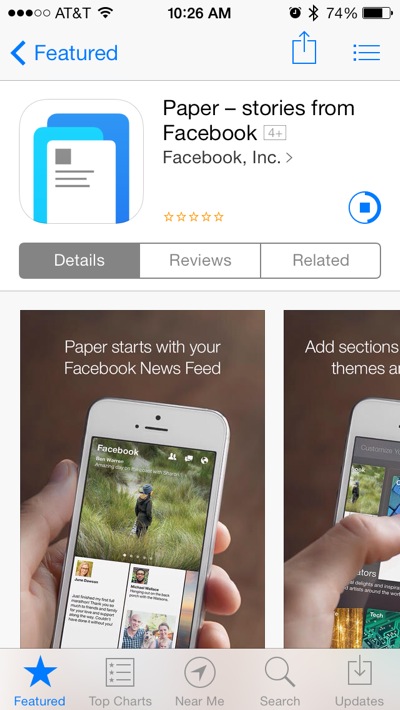 Paper is a free download from the App store, and signals a completely new way to interact with FaceBook, bridging the gap between news sources and your news feed.
Paper is a free download from the App store, and signals a completely new way to interact with FaceBook, bridging the gap between news sources and your news feed. When you first launch the app you are greater by a short video into showing off the application with the simple title screen shown here.
When you first launch the app you are greater by a short video into showing off the application with the simple title screen shown here.
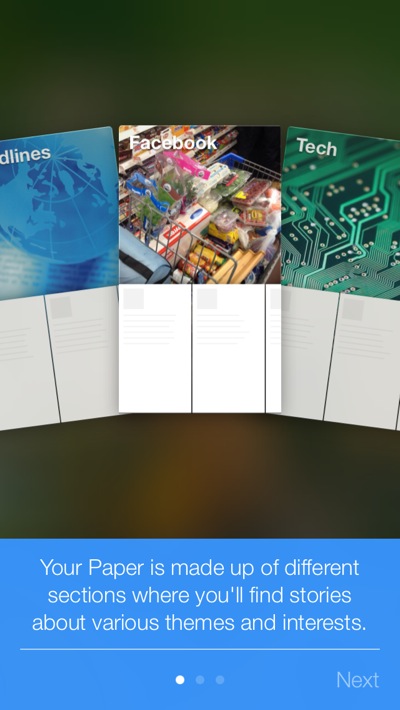 You are then guided through the process of adding additional news sections to your "Paper"
You are then guided through the process of adding additional news sections to your "Paper"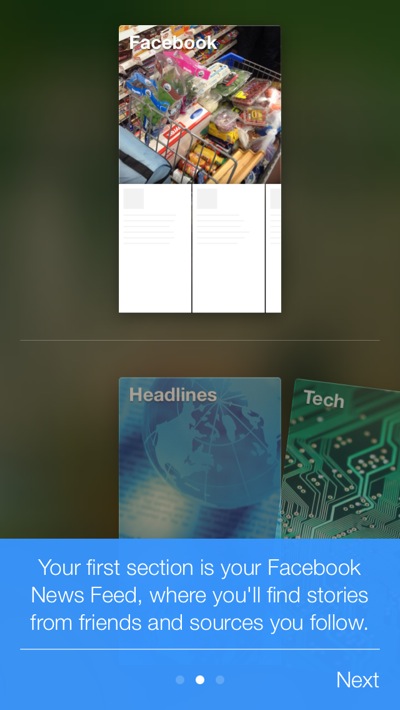 The tutorial guides you through the process explaining how the sections relate to each other.
The tutorial guides you through the process explaining how the sections relate to each other.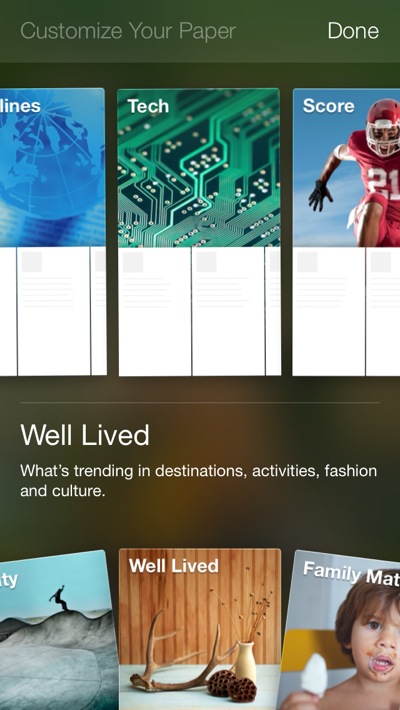 There are plenty of preconfigured sections available, and I would guess more will be coming as the application grows.
There are plenty of preconfigured sections available, and I would guess more will be coming as the application grows.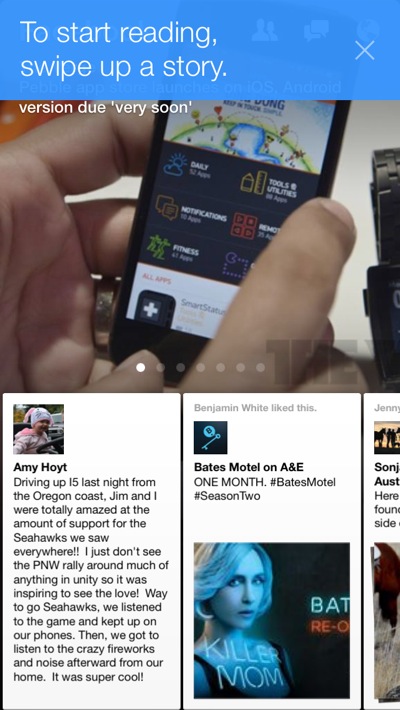 Once you finish adding sections, you are taken to your news feed. As you use the app, blue pop-over dialogs guide you through using the program.
Once you finish adding sections, you are taken to your news feed. As you use the app, blue pop-over dialogs guide you through using the program.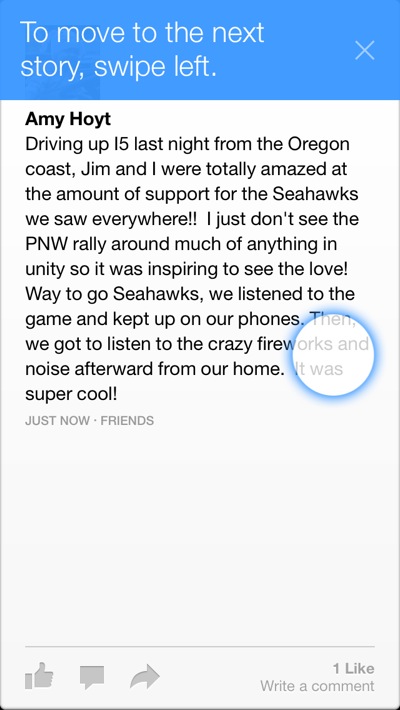
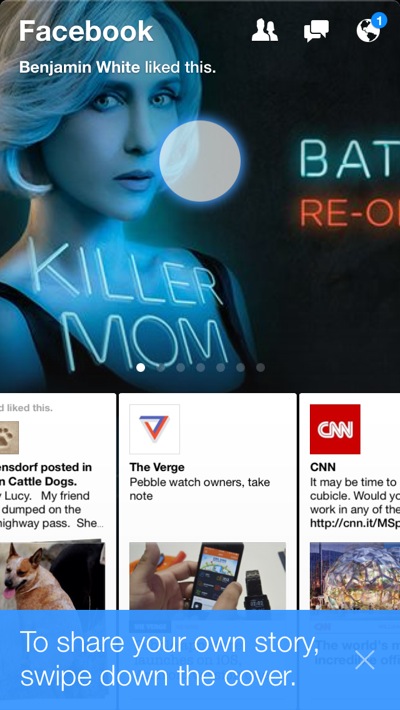
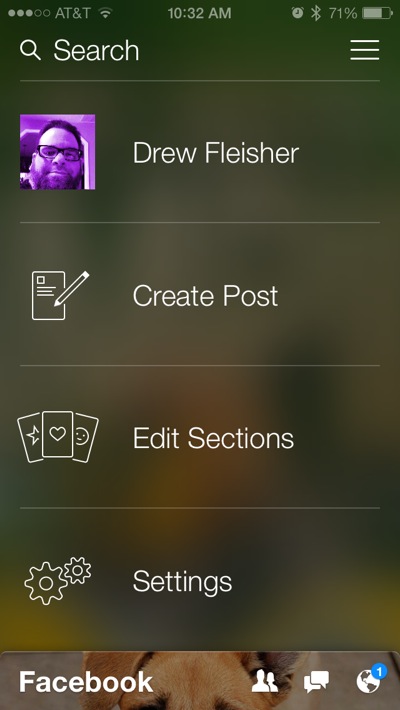
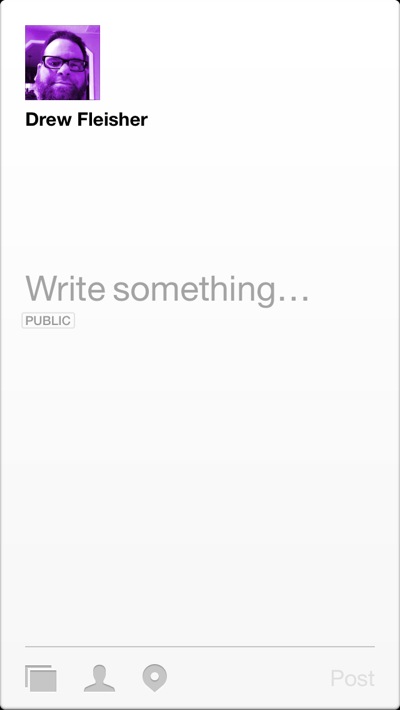 Adding a post has the same elegance of the rest of the app. They did this thing right, and it shows they didn't miss a trick.
Adding a post has the same elegance of the rest of the app. They did this thing right, and it shows they didn't miss a trick.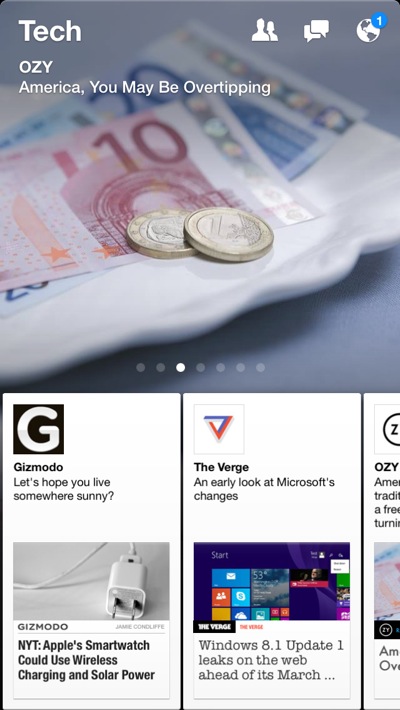 News sections are just as clean and easy to navigate. Swiping up takes you deeper, swiping down takes you back out closer to your timeline.
News sections are just as clean and easy to navigate. Swiping up takes you deeper, swiping down takes you back out closer to your timeline.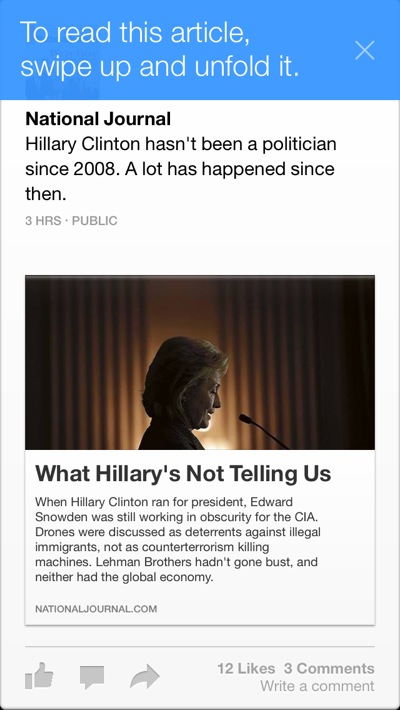 Once you've tapped on an article to bring it up, swiping up "unfolds it", taking you to the website that is the source of the original article.
Once you've tapped on an article to bring it up, swiping up "unfolds it", taking you to the website that is the source of the original article.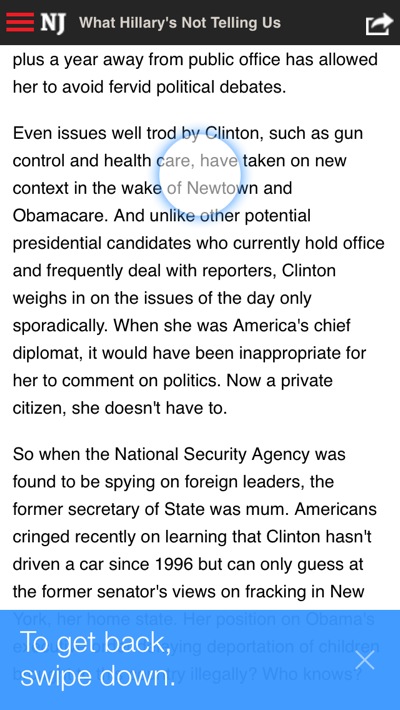
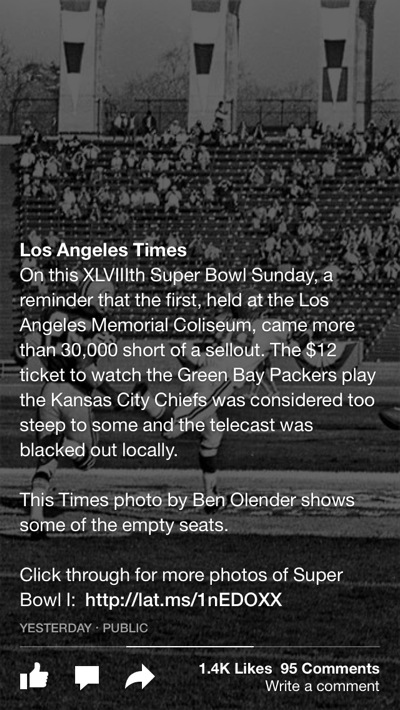 Photos on your timeline display full screen, and pan when you turn your phone if they are wider than the phone.
Photos on your timeline display full screen, and pan when you turn your phone if they are wider than the phone.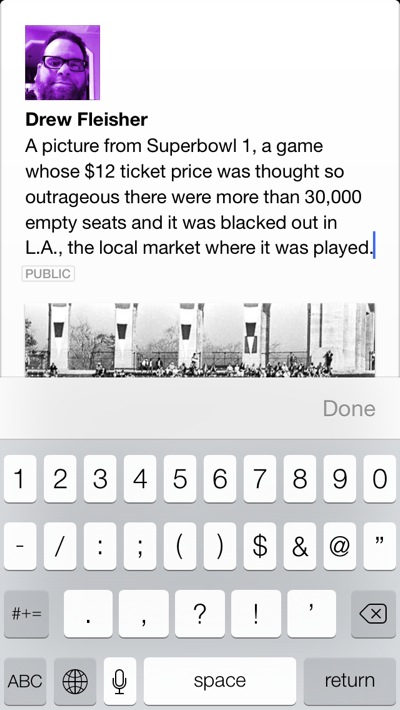 Re-posting a photo looks just as clean as anything else in the app. These guys really did a great job.
Re-posting a photo looks just as clean as anything else in the app. These guys really did a great job.
Conclusion
The folks on the Paper team have done what they were asked to do - try and disrupt FaceBook from the inside before someone outside had the chance to. Drawing on every design element Apple gave them to play with in iOS 7 this team has put together a smooth application that after just a few hours has replaced the regular FaceBook app on my iPhone, and I'm sure it will on yours as well. Trust me, once you spend a little time with it you will never go back.
Teknoholics Project: Mobile File sharing with PirateBox/LibraryBox

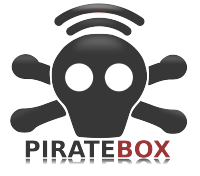
Last summer an interesting Kickstarter project launched, and was quickly funded at more than ten times it's requested ammount. The project was LibraryBox 2.0, a fork of the GNU GPLv3 licensed PirateBox art project by Dr. David Darts. The initial concept was to transform any space into a temporary communication and wireless file sharing network. When users join the PirateBox wireless network and open a web browser, they are automatically redirected to the PirateBox welcome page. Users can then immediately begin chatting and/or uploading or downloading files.
LibraryBox takes PirateBox to a little safer ground by sharing a library of files but no longer allowing people who connect to it the ability to upload potentially copywritten materials. The idea was the brain child of Jason Griffey an associate professor and head of Library Information Technology at the University of Tennessee at Chattanooga. His thought was that taking such a system into areas with limited or no internet access with a library of books, learning materials, disaster survival materials etc. could be of great assistance in disaster recovery areas, or foreign countries where access to the internet is severely regulated.
The project was featured in this months issue of MAKE: magazine, and since I already had the materials needed on hand I decided to play around with it to see how easy it was to get up and running.
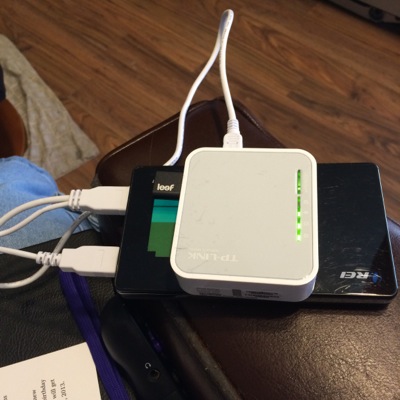
The foundation that the project is built on is a small wireless router from TP-Link, the MR3020. This small portable router is desgned to be used with 3G USB modems to share cellular data connections via wi-fi. The software of the router is overwritten with a program called OpenWRT, which for all intents and purposes turns the router into a web server.
The next thing that is needed is USB storage to house the files that are going to be shared. I used the Leef Fuse 2.0 32GB High-speed USB Flash Drive with Magnet Cap and PrimeGrade Memory (Charcoal/Black). I had other USB flash drives around, but this was the smallest with a decent capacity to be able to store data.
While that is all that is needed, to make my setup a little more portable and easier to deploy, I added a 12000mAh portable power bank that I had laying around.
So for you to build the exact setup I have put together would be less than $100. For that money you get a completely mobile filesharing device with 8-12 hours of uptime before it needs to be plugged in! Not a bad setup. You can use it to share files at a LAN Party, to share information at an outdoor event, or even as a kind of Digital GeoCache, where people can check-in on the wall to prove that they found it, and download a file or upload a file as well. The options are endless, and changes are relatively easy to make.
You can find the original project and instructions for the PirateBox here. Information on Jason Griffey's LibraryBox fork is available here, or in MAKE Volume 37, page 74.
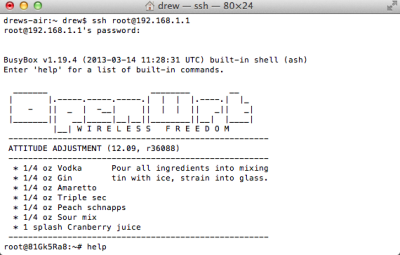 This is what you see in Terminal once you have connected to your MR3020 for the first time after it has been modified
This is what you see in Terminal once you have connected to your MR3020 for the first time after it has been modified
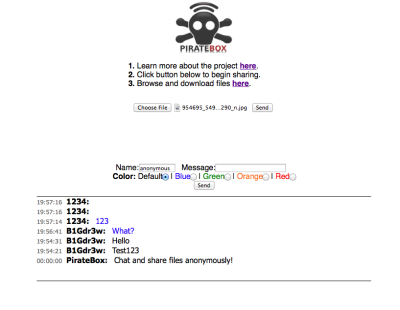 Uploading files and leaving notes on the chat board are easy tasks to accomplish
Uploading files and leaving notes on the chat board are easy tasks to accomplish
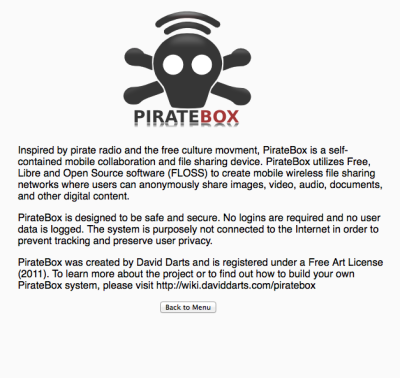 The main page information link takes you to this captive page with more details about the PirateBox concept
The main page information link takes you to this captive page with more details about the PirateBox concept
